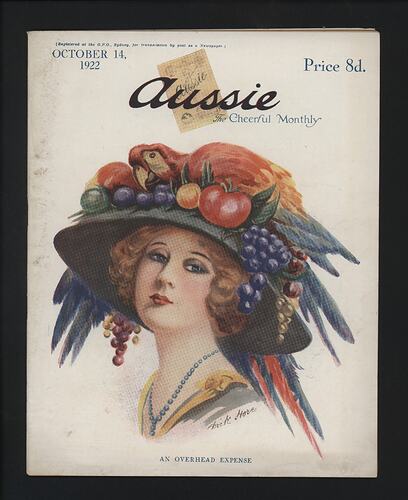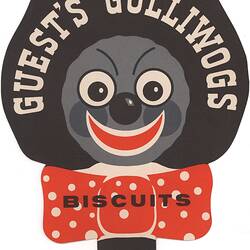Summary
Issue no. 44, 14 Oct 1922, of post-World War I publication 'Aussie', 'The Cheerful Monthly'.
One of a collection of copies of 'Aussie' magazines in Museum Victoria's collection dated 5 June 1918 - 15 January 1929.
'Aussie' (1918- circa 1929) was a commercial magazine of opinion, review and entertainment. It was edited by Phillip Harris and published in France 1918 - 1919 on a small printing press that Harris brought with him to France. Initially the print run was only 10,000 copies, but soon it reached 60,000 and later 100,000. The magazine celebrated a distinctive 'Aussie' identity through language, humour and imagery. It distributed news, provided light-hearted ways of seeing the war experience and gave soldiers an outlet to express dissent or dissatisfaction. It also provided a voice for Australian authors such as Banjo Paterson, C.J. Dennis and Bernard O'Dowd. Unfortunately, the magazine also frequently contained racist and sexist imagery and references.
After the war, Phillip Harris produced a monthly in Sydney and renamed it 'Aussie: the Cheerful Monthly' from 1920. It built a sizeable circulation and for several years it published the major Australian writers and cartoonists of the day. It set out to sustain the digger culture and defend the rights of the veterans, while also embracing the re-adjustment of returned soldiers into civilian life.
Physical Description
Magazine consists of 50 double sided pages stapled at the spine. The measurements are 22cm width x 27.5cm height. The cover page is printed in colour on thick white paper. Inner pages are printed in black and white on thin brown paper. The front cover features the title printed across the top over a picture of the old 'Aussie' magazine 1918-1919. Every issue has a different cartoon on the front drawn by Australian artists with a caption at the bottom. The magazine is comprised of stories, illustrations, songs and poetry from the First World War.
Significance
This object provides an Australian soldiers' view of the political and world climate during the immediate post World War I period. It also represents the bond between Australian soldiers, and the ongoing role of the AIF in Europe after the war. The magazine celebrated a distinctive 'Aussie' identity, through language, humour and their assertion of what it meant to be an Australian. It allowed news to be distributed, gave the soldiers an outlet to express any dissent or dissatisfaction, thus preventing any greater form of rebellion and promoted Australian authors like Banjo Paterson, C.J. Dennis and Bernard O'Dowd. After the war, Phillip Harris produced a monthly in Sydney from 1920 and renamed it: 'Aussie: the Cheerful Monthly'. It built a sizeable circulation and for more than a decade it published the major Australian writers and cartoonists of the day. It set out to sustain the digger culture and defend the rights of the veterans, while also embracing the re-adjustment of returned soldiers into civilian life.
'I claim no credit for the success of Aussie. That belongs to the Diggers. Aussie was not a paper done for the Diggers, but by them. That's why it reflects their spirit." - Phillip L. Harris, Editor, taken from 'The Story of Aussie'
More Information
-
Collection Names
Military Memorabilia Collection, Returned and Services League (RSL) Collection
-
Collecting Areas
-
Acquisition Information
Donation from Dr Field - Returned Services League of Australia (RSL), Jul 1982
-
Editor
-
Place & Date Published
-
Inscriptions
Printed on cover: Registered at the G.P.O., Sydney, for transmission by post as a Newspaper / OCTOBER 14, 1922 / Aussie The Cheerful Monthly / Price 8d. / ABRICK HORE / AN OVERHEAD EXPENSE
-
Classification
-
Category
-
Discipline
-
Type of item
-
References
Amanda Laugesen, 2003, 'Aussie Magazine and the Making of Digger Culture during the Great War' National Library of Australia News (November), pp.15 - 18
-
Keywords
Military Memorabilia, Militaria: Australian, Military History, World War I, 1914-1918, Magazines, Cultural Stereotypes

